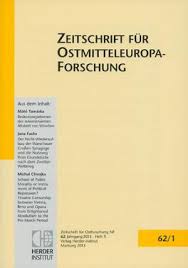Hildesheimer Bronzewerke des Hochmittelalters als Funde in Sibirien und Ostmitteleuropa. Ein Beitrag zur Wirtschaftsarchäologie
Medieval Bronze Objects Produced in Hildesheim as Findings in Siberia and East-Central Europe. A Contribution to Economic Archaeology
Author(s): Joanna OlchawaSubject(s): Archaeology, Economic history, Middle Ages
Published by: Verlag Herder-Institut
Keywords: aquamanilia; Hildesheim; bronze; Daniel Gottlieb Messerschmidt; Middle Ages; object history; economic history; economic archaeology;
Summary/Abstract: In 1721, during the course of Daniel Gottlieb Messerschmidt’s Siberian expedition, a number of small-scale bronze objects were found. Among them were so-called aquamanilia, vessels used for hand-washing rituals, as well as a candlestick in the form of a kneeling man. Though these unusual objects have since disappeared, a number of water-colour depictions of them still exist, which, on account of their detailed workmanship, give a good impression of the lost works. The originals have been identified as the so-called ‘Hildesheim Bronzes’ and were produced throughout the 13th century. The theory that they could have found their way to Russia during the Middle Ages is further strengthened by the fact that other artefacts originating from Hildesheim have been found, particularly in Eastern Central Europe, including the Czech Republic and the Ukraine, but also in Lithuania, Russia, Romania and as far afield as Georgia. The special character of aquamanilia as a commodity can be illustrated and clarified through the perspective of economic archaeology on account of the fact that, despite their sophisticated shapes and demanding, intricate craftsmanship, these vessels were clearly mass-produced and intended for export. In comparison to other objects, for example censers, crosses and crucifixes, which were also produced in Hildesheim but evidently not for commercial distribution, there appears to have been a special market-oriented focus on aquamanilia. Only they were in demand. This phenomenon can also be observed in the case of French and English silver vessels and Italian censers produced in the 12th and 13th centuries. Even the simple step of taking into account the sites where artefacts from Hildesheim have been found counts as a significant contribution to medieval economic history, as it gives a clear idea of how these objects were distributed via already well-known roads and waterways. Finally, the often applied approach of ‘object history’, which has attracted a great deal of academic commentary, can be seen as particularly relevant and rich in potential in the case of the Hildesheim Bronzes, as their reception is considered to be an essential part of the works themselves. Indeed, it is the lost artefacts, Messerschmidt’s Siberian findings, that form the starting point for scientific research into this art-form.
Journal: Zeitschrift für Ostmitteleuropa-Forschung
- Issue Year: 66/2017
- Issue No: 3
- Page Range: 324-353
- Page Count: 30
- Language: German

